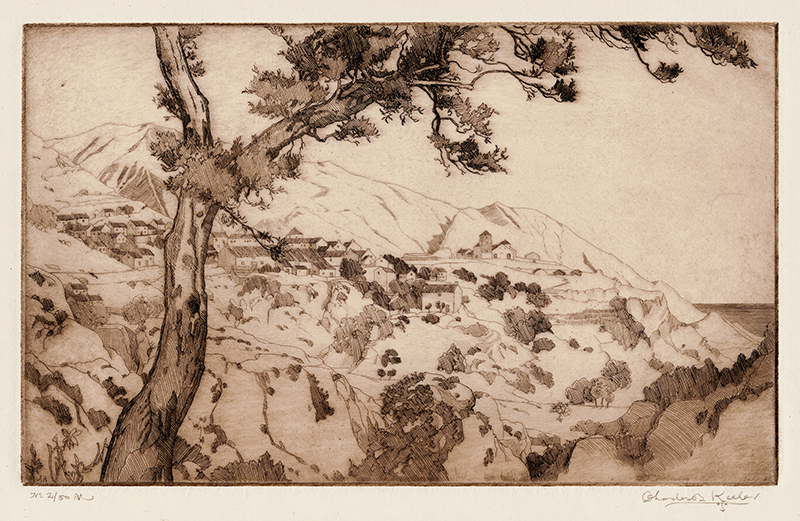A Village in Andalusia is an etching printed in sepia from 1925 by American artist Charles B. Keeler. It is listed on page x in Fine Prints of the Year 1925. A Village in Andalusia is pencil signed and editioned No 2/50 and bears the artist’s pencil cypher after the edition number and beneath his signature. It was printed by the artist on ivory laid paper and the platemark measures 7-1/4 x 11-3/4 inches.
Like many artists of his day, Charles Keeler traveled to numerous countries including France and Spain. The landscape and villages of Spain held a particular charm and he created at least ten prints from sketches drawn while traveling. Andalusia is an autonomous community and historical region of Spain. It is the southernmost region of Spain, comprised of hills, rivers, and farmland, and is bordered by the Mediterranean Sea, the Atlantic Ocean, and Portugal. The noted cities of the region are Seville and Granada.
Charles Butler Keeler, Jr., painter and printmaker, was born to Charles Butler and Ellen Rock Keeler in Cedar Rapids, Iowa on April 2, 1882. He received his Bachelor of Arts at Harvard University in 1905 and continued his studies at the Art Institute of Chicago. While in Chicago he studied printmaking with Bertha Jacques and B.].O. Nordfeldt and also studied with John Christen Johansen. In 1909, Butler traveled throughout England, France, and Germany. In 1912, he was in Spain and it is recorded that “he purchased a donkey and roamed about sketching the Sierra.” He spent time in the Spanish province of Málaga, recording the mountains and the mountaintop city of Ronda.
In 1918, Butler enlisted in the military at Camp Dodge, Iowa. He was assigned to the 339th Field Artillery and was made the company’s translator as he was fluent in French and was a delegate to camouflage school.
Keeler was a member of and exhibited with the Chicago Society of Etchers and the Print Makers Society of California. He was involved with the Torch Press, based in Cedar Rapids. He designed, etched, and printed the frontispiece and the title page for the Torch Press’ 1915 and 1916 popular Christmas series releases. He won an honorable mention for his aquatints at the 1915 Panama Pacific International Exposition in San Francisco. His prints were selected for Fifty Prints of the Year 1927 and Fine Prints of the Year 1929. Charles Butler Keeler’s work is represented in the Los Angeles County Museum of Art, California; the Library of Congress and the Smithsonian American Art Museum, Washington, D.C.
The 1930 United States Federal Census lists Keeler as married to Leila Love Brown Keeler and living in Azusa in Los Angeles County, California. He was living in Glendora, California when he signed his draft registration card in 1942 and then in 1956 was living in Dana Point.
Charles Butler Keeler died in Los Angeles on 19 January 1964.



